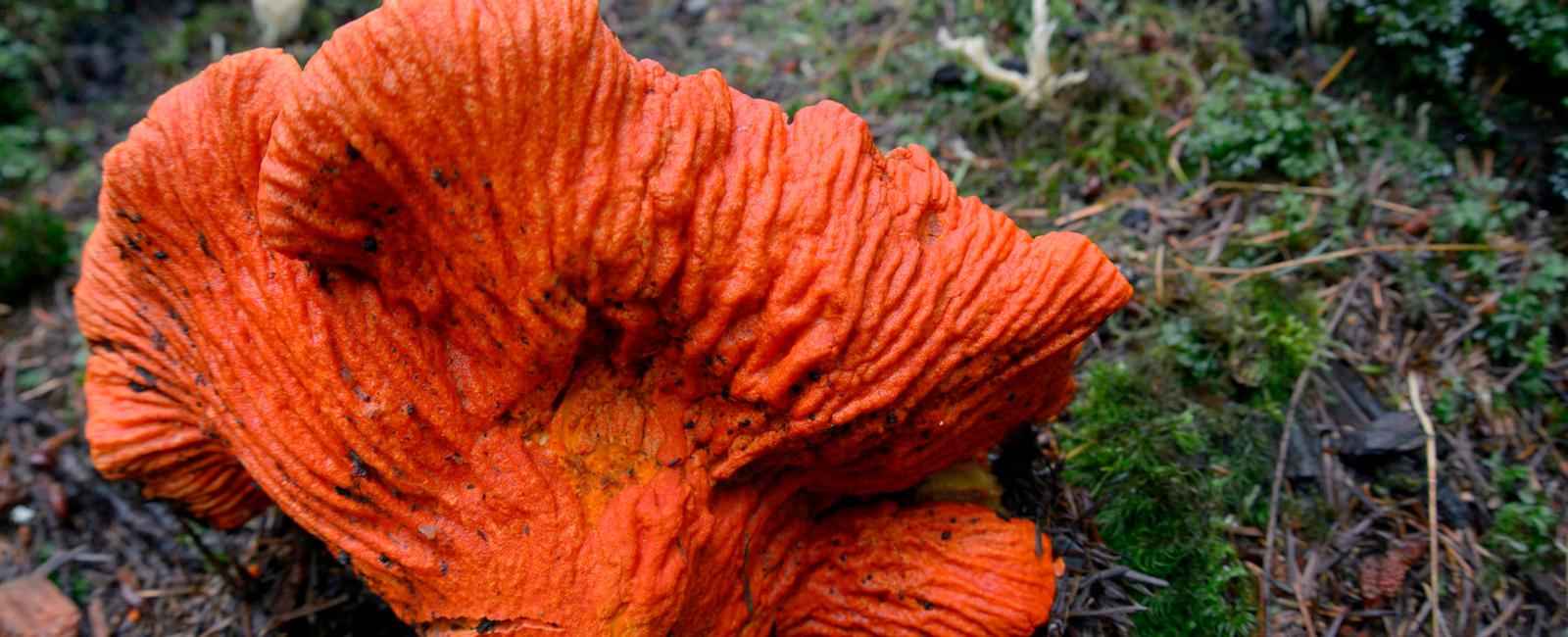

Occasionally, we talk about a mushroom that isn’t like other mushrooms for one reason or another. Maybe they glow like ghost mushrooms. Or maybe they take on an atypical shape because of their growth cycle and mold themselves to their host’s form, like cordyceps.
Lobster mushrooms are similar in their uniqueness. (Hint: They’re the result of a hostile fungal takeover in the mushroom kingdom).
In this article, we’ll talk about what lobster mushrooms are, what they look like, where you can find them, how to enjoy them, and more.
What are lobster mushrooms?
Lobster mushrooms, (hypomyces lactifluorum h. lactifluorum), are edible mushrooms. They aren’t commercially cultivated, so you’ll need to wildcraft or find these shrooms at farmers’ markets or specialty produce shops.
In a fashion not so different from cordyceps, lobster mushrooms aren’t precisely the same mushrooms they started as.
That’s right. Lobster mushrooms aren’t necessarily a specific variety of mushroom in the conventional sense. They’re what results when a parasitic fungus invades another mushroom species. Namely, lobster mushrooms are parasitic ascomycete fungus. And that fungus is extra picky about its host mushrooms, preferring Russula mushrooms (Russula brevipes or r. brevipes) and Lactarius mushrooms (Lactarius piperatus or l.piperatus) almost exclusively.
Once this fungus invades Lactarius or Russula species of mushrooms, they get a complete makeover. Everything about these mushrooms changes, from their appearance and shape to their taste. Instead of the host mushrooms producing their spores, the fungus essentially reprograms the mushrooms to start making its spores instead, which are spindle-shaped (1).
Its effect is so profound that researchers have discovered nearly all of the mushroom’s DNA will be that of the fungus, with only trace amounts of the original mushroom left (2).
The taxonomy for lobster mushrooms is as follows:
Kingdom: Fungi
Division: Ascomycota
Class: Sordariomycetes
Order: Hypocreales
Family: Hypocreaceae
Genera: Hypomyces
Species: H. lactifluorum
Psst: Even though this specific fungus almost always sticks with the two species mentioned above, they will, on occasion, colonize poisonous mushrooms, which makes proper mushroom identification especially important (3).
What do lobster mushrooms look like?
Their common name, lobster mushroom, hints at the appearance of these fascinating mushrooms, which are reminiscent of their crustacean namesake. Lobster mushrooms can be bright orange-red or reddish orange. These brightly colored varieties are considered prime choices for harvesting but there are some color variations to be aware of.
There’s a possibility of encountering white lobster mushrooms if they’ve only been partially infected by the parasite. Otherwise, you might see wine-colored mushrooms that lean toward purple and even pink. The general rule is to avoid eating older mushrooms (4). One tip-off you can’t miss? Older mushrooms will smell fishy, so steer clear (5).
Because of their brightly colored exteriors, lobster mushrooms are relatively easy to identify. Unlike most mushrooms, lobster mushrooms won’t have gills. Moreover, their exterior surfaces will be hard and rough, with mushroom caps that fold into irregular shapes. When you cut into a lobster mushroom, expect to find a dense interior that may vary from white to orange-white (4).
Where do lobster mushrooms grow?

Lobster mushrooms are easily found throughout the Pacific Northwest and down the West Coast along with parts of the East Coast, specifically in New England. It’s not uncommon to see them in other parts of North America, however, as some have also been found in parts of Colorado. There are even reports of lobster mushrooms growing in Europe and parts of Russia.
These mushrooms prefer to be under trees like Douglas Fir, Lodgepole, Ponderosa pines, and Hemlock trees.
A mostly midsummer mushroom, sometimes you can find lobster mushrooms in an area as late as October or even December. A good rule of thumb for finding lobster mushrooms starts with identifying where their preferred host mushroom species live. (3).
Psst: You might see lobster mushrooms classified as California fungi even though they grow plentifully outside of the state.
Historical and traditional use of lobster mushrooms
Without clear documentation, we cannot definitively say how lobster mushrooms may have been used in traditional medicine.
What we do know is that people worldwide have used wild food like mushrooms to support the human body in different ways. We can surmise that indigenous cultures may have incorporated lobster mushrooms into their cooking and traditions as they have with other medicinal and culinary mushrooms.
Health benefits of lobster mushrooms
Like other edible mushrooms, the lobster mushroom has impressive health benefits. Here are some reasons why these fungi can support your health and well-being:
- Brimming with vitamins and minerals: Lobster mushrooms are an excellent source of potassium, magnesium, calcium, selenium, essential amino acids, riboflavin, vitamins C, B1, B12, D, and E, and other bioactive compounds.
- Immune system support: The vitamins and minerals in lobster mushrooms help your immune system. Nutrients like B6 support the formation of healthy red blood cells, while vitamin D naturally boosts the immune system while reducing overall inflammation in your body.
- Better gut health: Mushrooms are a great source of prebiotics. The polysaccharides in mushrooms stimulate good bacterial growth, which is essential for good gut health (6).
Ethically wildcrafting lobster mushrooms

Ready to head out in search of local lobster mushrooms? If so, we recommend learning about the differences between foraging and ethically wildcrafting. While these terms may seem interchangeable, there are some essential differences.
Foraging is often used as a catch-all term for gathering wild food, whether mushrooms, berries, plants, or herbs. On the other hand, ethical wildcrafting is the practice of harvesting wild food sources for medicinal needs. Even more, ethical wildcrafting is a deeply mindful approach to gathering wild resources that considers both short- and long-term environmental consequences.
Learning the local area
Before you start looking for lobster mushrooms, it’s always a wise idea to learn more about the local area where you’ll be wildcrafting. An excellent way to start is by familiarizing yourself with some of the mushroom species you could encounter, as some may be endangered or threatened. Learning about any lookalike mushrooms is essential too. Keeping field guides handy can help with mushroom identification. If you’re unsure the mushrooms you’re gathering are safe, consult a mycologist or other professional.
Mushroom anatomy and harvesting
There’s often much more than meets the eye with wild mushrooms. Much of the time, what we see nestled on the forest floor or sprouting from logs is only part of the mushroom. The fruiting body is only part of a mushroom’s anatomy.
Beneath the surface lie delicate filaments called hyphae that serve as a communication system between mushrooms and other plants and trees around them. As these filaments grow and become more tightly woven together, they create what’s known as mycelium. Sometimes called the “wood wide web,” it’s a network for nutrient uptake and can communicate changes in the local environment.
Knowing the best way to harvest a mushroom can mean the difference between damaging the mycelium and leaving it intact. Equip yourself with the right tools so you can safely gather your mushrooms without negatively impacting the ecology of the local ecosystems.
Preserving the ecosystem
It might be easy to forget we aren’t the only ones enjoying wild mushrooms as part of our meals. Birds, deer, rodents, insects, and other animals all rely on mushrooms as part of their diets. Avoiding overharvesting is one way you can ensure plenty of mushrooms to go around.
Another alternative is to make a spore print from the mushrooms you gather. A spore print is an easy way to collect spores that you can use later to grow your mushrooms at home.
How can you enjoy lobster mushrooms?

Since lobster mushrooms aren’t commercially cultivated like the white mushrooms you see at your local grocery store, you’ll likely need to buy lobster mushrooms at specialty produce markets or check out your local farmers’ markets if you aren’t wildcrafting them yourself.
Once you have them, here are some of our favorite lobster mushroom recipes (or recipes where you can easily add fresh lobster mushrooms) to get you started in the kitchen.
Lobster mushroom pasta
Mushrooms and cream sauce are a perfect pairing in this quick and easy lobster mushroom recipe. Ready in under 20 minutes, it works equally well for lunch or dinner. Start by sautéing freshly sliced lobster mushrooms in butter and olive oil. Cook lobster mushrooms until they’re fully cooked and crisp on the edges. A parmesan cream sauce studded with freshly minced garlic and chopped parsley deliciously coats fettuccine noodles and those freshly cooked shrooms.
Wild mushroom risotto
Whether you’re new in the kitchen or a seasoned pro, we know some dishes can be intimidating, whether through effort, skill, technique, or all of the above. We have the perfect recipe if you’ve been curious about trying a mushroom risotto but have felt out of your depth. This instant pot mushroom risotto is weeknight-friendly, elegant enough for company, and endlessly adaptable to what you have on hand. Add hedgehog mushrooms, chanterelles, or fresh morels to your lobster mushrooms for a beautiful wild mushroom risotto.
Lobster mushroom chowder
Mushrooms are ideal for soups and lobster mushrooms are no different. Give these mushrooms a go in a New England-style chowder. Depending on where you live, clams might not be readily accessible. If that’s the case, this New England mushroom chowder is a must. Fresh lobster mushrooms mimic the chewiness of clams, while thick-cut bacon, heavy cream, and potatoes round out this filling chowder.
Cooked lobster mushrooms have a seafood-like flavor that works perfectly in seafood bisque, especially with homemade stock made with shellfish.
Psst: If you want to keep your lobster mushrooms as fresh as possible, treat them like any other fresh mushroom. Wrap them in paper towels and store them in a paper bag in the refrigerator. When you’re ready to use them, brush off any debris with a dry pastry brush or damp paper towel. No need to rinse in water as doing so can change their texture during cooking.
Lobster mushrooms: A colorful forest floor dweller
Lobster mushrooms are unforgettable not only for their unique origin story but also because their bright coloring stands out on the forest floor. With a delectable flavor, these mushrooms lend themselves to various dishes, whether a simple saute or dressed-up pasta dinner. Seeking out these nutrient-rich edible mushrooms is well worth the effort.
For more mushroom happenings, including news and breakthroughs on medicinal and psychedelic mushrooms, be sure and keep up with us on shroomer.
References
- Corsa, Sarah. “Lobster Mushroom.” Atlas Obscura. Accessed August 6, 2023. https://www.atlasobscura.com/foods/lobster-mushroom-northwest
- Canadian Science Publishing. “A Taste of the Wild—Deciphering the Lobster Mushroom | Canadian Science Publishing,” April 21, 2020. http://blog.cdnsciencepub.com/a-taste-of-the-wild-deciphering-the-lobster-mushroom/
- “Taste of the Wild: Lobster Mushroom,” n.d. http://www.bio.brandeis.edu/fieldbio/Edible_Plants_Ramer_Silver_Weizmann/Pages/spp_page_Hypomyces_lactifluorum.html
- “Vancouver Island Mushrooms - Lobster Mushroom Guide,” n.d. https://www.westcoastforager.com/wild-edible-mushrooms/lobster-mushroom-guide
- “Hypomyces Lactifluorum – Mushrooms Up! Edible and Poisonous Species of Coastal BC and the Pacific Northwest,” n.d. https://explore.beatymuseum.ubc.ca/mushroomsup/H_lactifluorum.html
- Bishop, Chelsea. “Health Benefits of Lobster Mushroom.” WebMD, December 16, 2022. https://www.webmd.com/diet/health-benefits-of-lobster-mushroom


